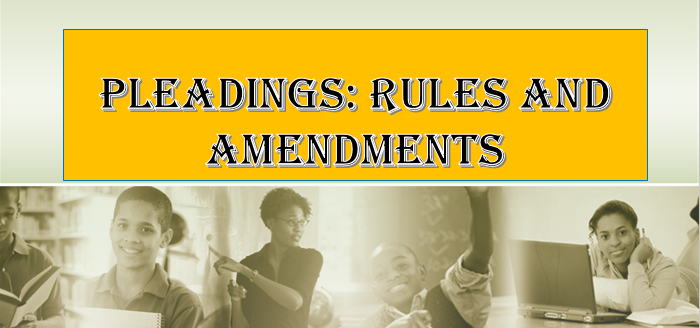Pleadings are the backbone of legal profession. It is the foundation stone on which case of a party stands. The case of a party must be set out in the pleadings. Moreover, the relief cannot be claimed on the grounds which are not contained in the pleadings. The immaterial or vague or ambiguous matter should be avoided and pleadings should be properly framed. In Devki Nandan v. Murlidhar,(1) it was held that a finding cannot be sustained which is based on no pleading and no evidence.
Pleadings are those materials or essential facts which are necessary to be averred in order to put forward a cause or to establish a defense in a judicial proceeding. It is the backbone of the suit upon which the entire edifice of the suit rests. It includes allegations and counter allegations made by one party and denied by the other.
Etymologically, it means a formal statement to propound the cause of action or set up a defence against the case of the plaintiff.(2) According to Mogha, “Pleadings are statements in writing drawn up and filed by each party to a case, stating what his contentions will be at the trial and giving all such details as his opponent needs to know in order to prepare his case in answer.”(3)
Order VI of the Code of Civil Procedure, 1908 deals with pleadings in general.
- Rule 1 defines pleading, while Rule 2 lays down the fundamental principles of pleadings.
- Rules 3 to 13 require the parties to supply necessary particulars.
- Rules 14 and 15 provide for signing and verification of pleadings.
- Rule 16 empowers a Court to strike out unnecessary pleadings.
- Rules 17 and 18 contain provisions relating to amendment of pleadings.
As per Rule 1 of Order VI of the Code of Civil Procedure, 1908, pleading is defined as plaint or written statement. It is important to know here the meaning of plaint and written statement.
Plaint is the statement of the plaintiff containing grievances in order to initiate an action in a court of law. It helps the court to determine the real nature of the suit.(4)
Written statement is the statement or defense of the defendant by which he either admits the claim of the plaintiff or denies the allegations or averments made by the plaintiff in his plaint.(5)
Object and Importance of Pleadings
The object of pleadings are –
(i) to bring the parties to definite issues;
(ii) to prevent surprise and miscarriage of justice;
(iii) to avoid unnecessary expense and trouble;
(iv) to save public time;
(v) to eradicate irrelevancy; and
(vi) to assist the Court.
Importance of pleading cannot be underestimated. Jacob states, “Pleadings do not only define the issues between the parties for the final decision of the court at the trial, they manifest and exert their importance throughout the whole process of the litigation.” Pleadings provide a guide for the proper mode of trial. They demonstrate upon which party the burden of proof lies, and who has the right to open the case. They also determine the range of admissible evidence which the parties should adduce at the trial. They also lay down limit on the relief that can be granted by the Court.(7)
Rules of Pleadings
For the proper understanding of rules of pleadings it may be divided into two heads:-
(A) Fundamental or Basic Rules; and
(B) Particular or Other Rules
(A) Fundamental or Basic Rules of Pleadings:-
Sub-rule (1) of Rule 2 of Order VI of the Code of Civil Procedure, 1908, lays down the fundamental principles of pleadings. It reads as under:-
“Every pleading shall contain, and contain only a statement in a concise form of the material facts on which the party pleading relies for his claim or defense, as the case may be, but not the evidence by which they are to be proved.”
From the above provision it can be said that following are the fundamental or basic rules of pleadings:-
- Pleadings should state facts and not law;
- The facts stated in pleadings should be material facts;
- Pleadings should not state the evidence; and
- The facts in pleadings should be stated in a concise form.
Now these rules are discussed in details one by one:-
(1) Pleadings should state facts and not law:-
It is the first fundamental rule of pleadings. It says that pleadings should state only facts and not law. In the case of Kedar Lal v. Hari Lal,(8) it was held that it is the duty of the parties to state only the facts on which they rely upon their claims. It is for the Court to apply the law to the facts pleaded. In the case of Gouri Dutt Ganesh Lall Firm v. Madho Prasad,(9) it was held that the law of pleading may be tersely summarized in four words; “Plead facts not law.”
In Ram Prasad v. State of M.P.,(10) it was held that a mixed question of law and fact, however, should be specifically pleaded. Again in Union of India v. Sita Ram Jaiswal,(11) the Court held that a point of law which is required to be substantiated by facts should be pleaded with necessary facts.
(2) The facts stated in pleadings should be material facts:-
It is the second fundamental rule of pleadings. It says that pleadings should contain a statement of material facts and material facts only. Here one most important question is arose i.e. what is the meaning of the term “material facts”.
This term has not been defined in the Code of Civil Procedure, 1908. But the Court defined this term in many judicial pronouncements.
Union of India v. Sita Ram
Like in the case of Union of India v. Sita Ram,(12) the court said that “material facts” means all facts upon which the plaintiff’s cause of action or the defendant’s defence depends, or in other words, all those facts which must be proved in order to establish the plaintiff’s right to relief claimed in the plaint or the defendant’s defence in the written statement.
Udhav Singh v. Madhav Rao Scindia,
Again in the case of Udhav Singh v. Madhav Rao Scindia,(13) the Supreme Court said that the term material fact means “All the primary facts which must be proved at the trial by a party to establish the existence of a cause of action or his defence are material facts.”
Virender Nath v. Satpal Singh
Again in Virender Nath v. Satpal Singh,(14) the Supreme Court held that:- “The phrase ‘material facts’ may be said to be those facts upon which a party relies for his claim or defence.
In other words, ‘material facts’ are facts upon which the plaintiff’s cause of action or the defendant’s defence depends. What particulars could be said to be ‘material facts’ would depend upon the fats of each case and no rule of universal application can be laid down.
It is, however, absolutely essential that all basic and primary facts which must be proved at the trial by the party to establish the existence of a cause of action or defence are material facts and must be stated in the pleading by as the party.”
In the same case the Supreme Court also said:- “A distinction between ‘material facts’ and ‘particulars’, however, must not be overlooked.
‘Material facts’ are primary or basic facts which must be pleaded by the plaintiff or by the defendant in support of the case set up by him either to prove his cause of action or defence.
‘Particulars’, on the other hand, are details in support of material facts pleaded by the party. They amplify, refine and embellish material facts by giving distinctive touch to the basic contours of a picture already drawn so as to make it full, more clear and more informative.
‘Particulars’ thus ensure conduct of fair trial and would not take the opposite party by surprise.”
The Supreme Court further said that whether a particular fact is or is not a material fact which is required to pleaded by a party depends on the facts and circumstances of each case.
(3) Pleadings should not state the evidence:-
It is third fundamental rule of pleadings. It says that pleadings should contain a statement of material facts on which the party relies but not the evidence by which those facts are to be proved. The facts are of two types:-
(a) Facta probanda- the facts required to be proved (material facts); and
(b) Facta probantia- the facts by means of which they are to be proved (particulars or evidence).
The pleadings should contain only facta probanda and not facta probantia. The material facts on which the plaintiff relies for his claim or the defendant relies for his defence are called facta probanda, and they must be stated in the plaint or in the written statement, as the case may be. But the facts or evidence by means of which the material facts are to be proved are called facta probantia and need not be stated in the pleadings.
(4) The facts in pleadings should be stated in a concise form:-
It is the fourth and last fundamental rule of pleadings. It says that the statements in pleadings should be stated in a concise and in brief form. In Virendra Kashinath v. Vinayak N. Joshi,(15) The words “in a concise form” are definitely suggestive of the fact that brevity should be adhered to while drafting pleadings. Of course, brevity should not be at the cost of excluding necessary facts, but it does not mean niggling in the pleadings. If care is taken in syntactic process, pleadings can be saved from tautology.
(B) Particular or Other Rules of Pleadings:-
Besides the fundamental or basic rules of pleadings, there are other or particular rules of pleadings which are as follows:-
- Wherever misrepresentation, fraud, breach of trust, willful default or undue influence are pleaded in the pleadings, particulars with dates and items should be stated.(16)
- The performance of a condition precedent need not be pleaded since it is implied in the pleadings. Non-performance of a condition precedent, however, must be specifically and expressly pleaded.(17)
- Generally departure from pleading is not permissible, and except by way of amendment, no party can raise any ground of claim or contain any allegation of fact inconsistent with his previous pleadings.(18)
- A bare denial of a contract by the opposite party will be construed only as a denial of factum of a contract and not the legality, validity or enforceability of such contract.(19)
- Documents need not be set out at length in the pleadings unless the words therein are material.(20)
- Wherever malice, fraudulent intention, knowledge or other condition of the mind of a person is material, it may be alleged in the pleading only as a fact without setting out the circumstances from which it is to be inferred.(21) Such circumstances really constitute evidence in proof of material facts.
- Whenever giving of notice to any person is necessary or a condition precedent, pleadings should only state regarding giving of such notice, without setting out the form or precise term of such notice or the circumstances from which it is to be inferred, unless they are material.(22)
- Implied contracts or relations between persons may be alleged as a fact, and the series of letters, conversations and the circumstances from which they are to be inferred should be pleaded generally.(23)
- Facts which the law presumes in favour of a party or as to which the burden of proof lies upon the other side need not be pleaded.(24)
- Every pleading should be signed by the party or one of the parties or by his pleader.(25)
- A party to the suit should supply his address. He should also supply address of the opposite party.(26)
- Every pleading should be verified on affidavit by the party or by one of the parties or by a person acquainted with the facts of the case.(27)
- A Court may order striking out a pleading if it is unnecessary, scandalous, frivolous, vexatious or tends to prejudice, embarrass or delay fair trial of the suit.(28)
- A Court may allow amendment of pleadings.(29)
- Forms in Appendix A of the Code should be used wherever they are applicable. Where they are not applicable, forms of like nature should be used.(30)
- Every pleading should be divided into paragraphs, numbered consecutively. Each allegation or averment should be stated in a separate paragraph. Dates, totals and numbers should be written in figures as well as in words.(31)
Amendment of Pleadings
Amendment is the formal revision or addition or alteration or modification of the pleadings. Provisions for the amendment of pleadings are intended for promoting the ends of justice and not for defeating them. Rules 17 and 18 of Order VI of Code of Civil Procedure, 1908 deals with provisions regarding amendment of pleadings and failure to amend after order respectively. Rule 17 of the Code of Civil Procedure, 1908 provides that, “The Court may at any stage of the proceedings allow either party to alter or amend his pleadings in such manner and on such terms as may be just, and all such amendments shall be made as may be necessary for the purpose of determining the real questions in controversy between the parties.
Proviso to the Rule 17 of Order VI of Code of Civil Procedure, 1908 as inserted by the Code of Civil Procedure (Amendment) Act, 2002 restricts and curtails power of the Court to allow amendment in pleadings by enacting that no application for amendment should be allowed after the trial has commenced, unless the Court comes to the conclusion that in spite of due diligence, the party could not have raised the matter before the commencement of trial.
Amendment of pleadings when granted:-
Amendment of pleadings can be granted by the Court in two situations namely, (i) where the amendment is necessary for the determination of the real question in controversy; and (ii) can the amendment be allowed without injustice to the other side.
Amendment of pleadings when refused:-
Amendment of pleadings can be refused in many circumstances. Following are the situations or circumstances when amendment of pleadings can be refused by the Court:-(32)
(1) When the proposed amendment is unnecessary.
(2) When the proposed amendment causes an injury to the opposite party which cannot be compensated for by costs.
(3) When the proposed amendment changes the nature of the case.
(4) When the application for amendment is not made in good faith.
(5) When there has been an excessive delay in filing the amendment application.
Failure to amend:- Rule 18 of Order VI of Code of Civil Procedure, 1908 deals with this issue. It provides that if a party who has obtained an order for leave to amend does not amend accordingly within the time limited for that purpose by the order, or if no time is thereby limited then within 14 days from the date of the order, he shall not be permitted to amend after the expiration of such limited time as aforesaid or of such 14 days, as the case may be, unless the time is extended by the Court.
Conclusion
Pleadings do not only define the issues between the parties for the final decision of the court at the trial, they manifest and exert their importance throughout the whole process of the litigation. Pleadings provide a guide for the proper mode of trial.
They demonstrate upon which party the burden of proof lies, and who has the right to open the case. They also determine the range of admissible evidence which the parties should adduce at the trial.
They also lay down limit on the relief that can be granted by the Court.
Four fundamental rules of pleading are;
(1) Pleadings should state facts and not law;
(2) The facts stated in pleadings should be material facts;
(3) Pleadings should not state the evidence; and
(4) The facts in pleadings should be stated in a concise form.
The main points to be considered before a party is allowed to amend his pleading are: firstly, whether the amendment is necessary for the determination of the real question in controversy; and secondly, can the amendment be allowed without injustice to the other side.
Endnotes
- AIR 1957 SC 133.
- Srivastava K. K. Dr., The Law of Pleadings, Drafting and Conveyancing, 8th Edition, Central Law Agency, Allahabad, 2014, p. 1.
- Mogha’s Law of Pleadings (1983) at p. 1.
- Srivastava K. K. Dr., The Law of Pleadings, Drafting and Conveyancing, 8th Edition, Central Law Agency, Allahabad, 2014, p. 126.
- Ibid, p. 141.
- (1876) 3 Ch D 637.
- Takwani C. K., Civil Procedure with Limitation Act, 1963, 7th Edition, Eastern Book Company, Lucknow, 2013, pp. 194-195.
- AIR 1952 SC 47 at p. 51: 1952 SCR 179.
- AIR 1943 PC 147: 209 IC 192.
- (1969) 3 SCC 24: AIR 1970 SC 1818.
- (1976) 4 SCC 505: AIR 1977 SC 329.
- Ibid.
- (1977) 1 SCC 511: AIR 1976 SC 744.
- (2007) 3 SCC 617: AIR 2007 SC 581.
- (1999) 1 SCC 47 at p.52: AIR 1999 SC 162 at p. 165.
- Rule 2(2), 2(3), 3, 4,6,7,8,9,10,11,12,13,14,14-A,15,16,17, of Order VI of the Code of Civil Procedure, 1908.
- Srivastava K. K. Dr., The Law of Pleadings, Drafting and Conveyancing,8th Edition, Central Law Agency, Allahabad, 2014, p. 80
Article by Ritesh kumar









